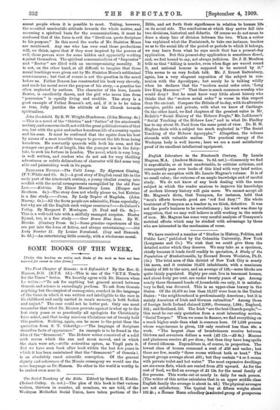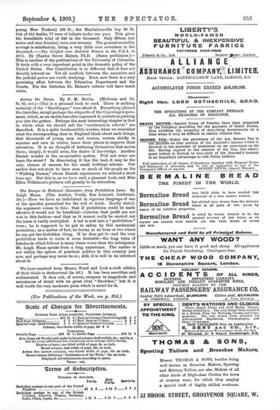We have received a number of "Studies in History, Politics,
and Public Law," published by the Columbia University, New York (Longmans and Co.) We wish that we could give them the detailed notice which they deserve. We may take as a specimen, chiefly because it lends itself readily to quotation, A Study of the Population of Manhatlanville, by Howard Brown Woolaton, Ph.D. (5s.) The total area of this district of New York City is nearly 144 acres, and it contains 18,476 inhabitants, with a maximum density of 395 to the acre, and an average of 128,—some blocks are quite thinly populated. Eighty per cent live in tenement houses, and about forty per cent. are under twenty years of age. Among nearly three thousand heads of _households one only, it is satisfac- tory to find, was divorced. This is an upper-class luxury in the States. Of the 18,476 no less than 13,157 were born in the United States : "the neighbourhood is predominantly American; but it is mainly American of Irish and German extraction." Among those of foreign birth Ireland claimed 2,008; Germany, 1,684; England, 352; and Scotland, 105. The Irish "are the best Church-people,"--- this must be our only quotation from a most interesting section, "Social Temper." When we come to finance, we find everything on a much higher scale than what is common here. Of 1,538 persons whose wage-income is given, 119 only received less than 48s a week. "The largest class of breadwinners receive between thirteen and seventeen dollars a week (£2 128.—.433 8s.) Masons and plasterers receive £1 per diem ; but then they have long spells of forced idleness. Expenditure is, of course, in proportion. The lowest class of houses ,c,ommand a rent of £36 and under; but these are few, mostly "three rooms without bath or heat" The largest groups average about £51; but they contain "4 or 5 rooms with private toilet and hot water." The most expensive dwellings are six-room flats, which are rented from £72 upward. As for the cost of food, we find an average of -el 12s. for the usual family of five persons. This works out at nearly is. daily for each person. (The writer of this notice calculates that in an upper middle class English family the average is about is. 4cL) The physical averages are not satisfactory. The typical boy at fifteen weighs about 103 lb.; a florae° Mann schoolboy (*selected group of prosperous young New Yorkers) 108 lb. ; the Manhattanville boy 89 lb. Out of 312 deaths, 77 were of infants under one year. This gives the formidable total of 246 in the thousand. Only fifteen (six males and nine females) were over seventy. The general mortality average is satisfactory, being a very little over seventeen in the thousand.—The Conflict over Judicial Powers in the U.S.A. to 1870. By Charles Grove Haines, Ph.D. (Same publishers.)— This is another of the publications of the University of Columbia. It deals with a very important point in the domestic policy of the United States. Our Constitution is so different that it does not directly interest us. Yet all conflicts between the executive and the judicial power are worth studying. Even now there is a. very promising affair between the Education Department and the Courts. For the historian Dr. Haines's volume will have much value.







































 Previous page
Previous page